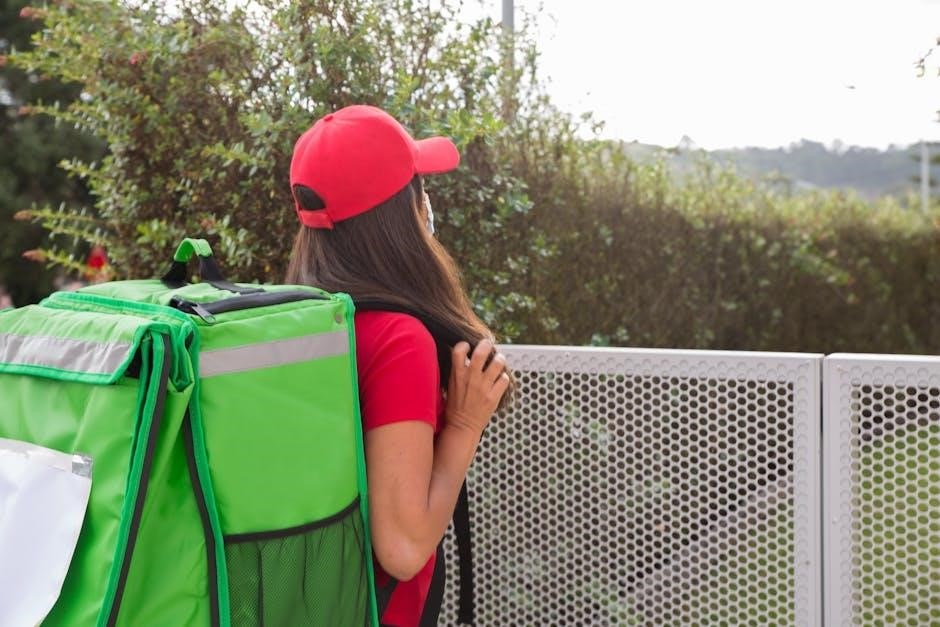Boppy Carrier Instructions: A Comprehensive Guide
Boppy baby carriers offer parents a comfortable and secure way to keep their little ones close. This comprehensive guide provides essential information, covering various models, safety tips, and care instructions for optimal use.
Boppy baby carriers are designed to offer parents a blend of comfort, security, and convenience while keeping their little ones close. These carriers are crafted with both the parent and baby in mind, aiming to provide ergonomic support and ease of use. Boppy offers various carrier models, each tailored to meet different needs and preferences, from newborns to older babies.
The Boppy ComfyFit, ComfyChic, and ComfyGrow carriers are among the popular choices, providing different features like adjustable straps, hip-healthy positioning, and easy-to-clean materials. Understanding the unique attributes of each Boppy carrier ensures parents can select the perfect fit for their lifestyle. Proper usage and adherence to safety guidelines are essential for ensuring a positive and secure babywearing experience. This guide will explore Boppy carrier options, step-by-step instructions, and safety measures for confident babywearing.

Understanding Different Boppy Carrier Models
Boppy offers a range of baby carriers designed for various needs. Each model, like the ComfyFit, ComfyChic, and ComfyGrow, provides unique features to support both parent and baby comfortably and securely.
Boppy ComfyFit Carrier
The Boppy ComfyFit Carrier offers a simple, comfortable, and secure babywearing experience in a compact design. This hybrid carrier is thoughtfully created for security and connection, eliminating unnecessary bulk. It’s acknowledged by the International Hip Dysplasia Institute as a “hip-healthy” product when used correctly, ensuring proper hip positioning for your baby.
Learning to use the ComfyFit is easy and fun, but always read the instruction manual thoroughly. The carrier is machine washable on a gentle cycle with mild detergent and can be tumble dried on low. It should not be ironed.
The ComfyFit is designed for newborns and infants, providing a snug and supportive fit. Its intuitive design makes it an excellent choice for parents new to babywearing, offering both comfort and peace of mind.
Boppy ComfyChic Carrier
The Boppy ComfyChic Carrier distinguishes itself with a blend of style and functionality, offering a fashionable yet practical babywearing solution. This carrier prioritizes both parent and baby comfort, featuring soft, breathable fabrics and adjustable straps for a customized fit. Its design often incorporates elegant details and color options, making it a chic accessory for everyday wear.
While specific instructions vary, the ComfyChic typically supports multiple carrying positions, adapting to your baby’s growth and developmental stages. Always consult the included manual for detailed guidance on proper usage and safety precautions. Like other Boppy carriers, ensuring proper hip positioning is crucial.
Regular cleaning is essential to maintain hygiene, usually involving machine washing on a gentle cycle. The ComfyChic provides a stylish and secure way to keep your baby close while on the go.
Boppy ComfyGrow Carrier
The Boppy ComfyGrow Carrier is designed to adapt seamlessly to your growing child, offering multiple carrying positions suitable from infancy through toddlerhood. This versatile carrier features adjustable seat widths and head supports, ensuring optimal comfort and ergonomic positioning as your baby develops. The ComfyGrow prioritizes ease of use, with intuitive adjustments and secure buckles for quick and confident wearing.
Its ergonomic design promotes healthy hip development, acknowledged by the International Hip Dysplasia Institute when used as directed. Always refer to the instruction manual for specific guidance on each carrying position and weight limits. Regular cleaning, typically machine washing on a gentle cycle, is essential for maintaining hygiene.
The Boppy ComfyGrow provides a long-lasting and supportive babywearing solution that evolves with your child’s needs. This carrier ensures both comfort and safety as your little one grows.

Choosing the Right Boppy Carrier for You
Selecting the perfect Boppy carrier depends on your needs and preferences. Consider your baby’s age, weight, and your comfort level. Explore different models to find the best fit for you and your child.
Considering Baby’s Age and Weight
When selecting a Boppy carrier, your baby’s age and weight are critical factors. Each carrier model has specific weight limits and age recommendations to ensure safety and comfort. Newborns require carriers that provide proper head and neck support, such as the Boppy ComfyFit.
As your baby grows, you can transition to carriers that offer more flexibility, like the ComfyChic or ComfyGrow. Always check the carrier’s weight limit to prevent overstressing the fabric and compromising safety. Ensure that the carrier is appropriately sized for your baby to maintain a secure and comfortable fit.
Using a carrier designed for the wrong age or weight can lead to discomfort for both you and your baby, and it may also pose a safety risk. Regularly reassess your baby’s size to guarantee the chosen carrier remains suitable. Prioritize safety and comfort above all else when making your selection.
Assessing Comfort and Support
Comfort and support are paramount when choosing a Boppy carrier. Evaluate the carrier’s design to ensure it distributes your baby’s weight evenly, preventing strain on your back and shoulders. Padded shoulder straps and a supportive waistband can significantly enhance your comfort during extended wear.
Consider the fabric’s breathability to avoid overheating, especially in warmer climates. Look for carriers made from soft, gentle materials to prevent irritation to your baby’s skin. The Boppy ComfyFit and ComfyChic carriers often feature adjustable components, allowing you to customize the fit for optimal support.
A well-fitting carrier should keep your baby snug and secure without restricting their movement. Test different positions to find what works best for both you and your baby. Proper support ensures your baby maintains a healthy hip position, reducing the risk of dysplasia. Prioritizing comfort and support will make babywearing a pleasant experience for everyone involved.

Step-by-Step Instructions for Using the Boppy ComfyFit Carrier
Using the Boppy ComfyFit carrier involves preparing the carrier, correctly positioning your baby for a front carry, and adjusting the straps to ensure a secure and comfortable fit.
Preparing the Carrier
Before placing your baby in the Boppy ComfyFit carrier, it’s essential to prepare the carrier properly for a safe and comfortable experience. Start by familiarizing yourself with all the components of the carrier, including the waist belt, shoulder straps, and buckles. Ensure that all buckles are securely fastened and in good working condition. Adjust the waist belt to fit snugly around your waist, positioning it so that the carrier sits comfortably on your hips.
Next, loosen the shoulder straps to allow for easy entry and adjustment once your baby is in place. Make sure that the fabric of the carrier is free from any twists or folds, providing a smooth and even surface for your baby to rest against. Practice putting the carrier on and taking it off a few times to become comfortable with the process before placing your baby inside.
Finally, review the instruction manual that comes with your Boppy ComfyFit carrier. This will help you understand all of the product’s features.
Positioning Your Baby (Front Carry)
When using the Boppy ComfyFit carrier for a front carry, proper positioning of your baby is crucial for their comfort and safety. Ensure your baby is facing towards you, with their chest against your body. Their legs should be in a natural, frog-legged position, with their knees higher than their bottom to promote healthy hip development.
Make sure their back is supported in a natural curve, not forced straight; Their face should be visible and clear of the carrier fabric, allowing for easy breathing and monitoring. Gently guide your baby into the carrier, ensuring their weight is evenly distributed. Adjust the fabric around your baby to provide adequate support to their head and neck, especially for newborns who lack head control.
Always keep a hand on your baby while positioning them to prevent falls. Regularly check your baby’s position to ensure they remain comfortable and safe throughout the carry.
Adjusting the Straps for a Secure Fit
Achieving a secure and comfortable fit with your Boppy ComfyFit carrier involves careful adjustment of the straps. Begin by tightening the waist belt so that it sits snugly around your waist, providing a stable base for the carrier. Next, adjust the shoulder straps to distribute your baby’s weight evenly across your shoulders and back. The straps should be snug but not too tight, allowing you to breathe comfortably and maintain good posture.
Pay attention to the chest strap, ensuring it is positioned comfortably across your chest without digging in. This strap helps to prevent the shoulder straps from slipping off your shoulders. For a newborn, ensure the head and neck support is properly adjusted to cradle their head securely.
Check that there is no excessive sagging or looseness in the carrier fabric, as this could compromise your baby’s safety and comfort. Make small, incremental adjustments until you achieve a snug, secure fit that allows you to move freely while keeping your baby close.

Safe Usage Guidelines for Boppy Carriers
Prioritize your baby’s safety by adhering to guidelines. Ensure proper hip positioning for healthy development. Monitor breathing, respect weight limits, and follow age recommendations to prevent accidents or discomfort.
Ensuring Proper Hip Positioning (Hip-Healthy)
Proper hip positioning is crucial when using a Boppy carrier, supporting healthy hip development. The International Hip Dysplasia Institute (IHDI) acknowledges the Boppy ComfyFit Baby Carrier as “hip-healthy” when used as directed. This means ensuring the baby’s legs are in a natural “M” position, with knees higher than the bottom and thighs supported.
Avoid positioning the baby’s legs straight down or pressed tightly together, as this can hinder healthy hip joint development. Check that the carrier supports the baby’s thighs all the way to the knee, preventing dangling. Regularly check your baby’s position within the carrier, making adjustments as needed to maintain the optimal “M” shape.
When using a Boppy carrier, familiarize yourself with the specific instructions for achieving hip-healthy positioning. If you have concerns about your baby’s hip health, consult with a pediatrician or other healthcare professional.
Remember, a hip-healthy carrier promotes comfortable and natural positioning, contributing to your baby’s overall well-being. Always prioritize safety and proper usage when babywearing.
Monitoring Baby’s Breathing
When using a Boppy carrier, diligently monitor your baby’s breathing to ensure their safety and well-being. Ensure the carrier does not obstruct the baby’s nose or mouth, allowing for unobstructed airflow. Regularly check that your baby’s chin is not pressed against their chest, as this can restrict breathing.
Position your baby high enough in the carrier so that you can easily see their face and monitor their breathing patterns. Be especially vigilant during the first few months, when newborns have less head and neck control. Listen for any signs of labored breathing, such as wheezing or gasping.
If you notice any breathing difficulties, immediately reposition your baby to ensure clear airways. In cases of persistent breathing problems, remove the baby from the carrier and seek medical attention. Avoid using the carrier while engaging in strenuous activities that could compromise your ability to monitor your baby’s breathing effectively.
Maintaining constant awareness of your baby’s respiratory status is paramount when using a Boppy carrier, ensuring their comfort and safety.
Weight Limits and Age Recommendations
Adhering to the weight limits and age recommendations for your Boppy carrier is crucial for the safety and comfort of your baby. Each Boppy carrier model has specific guidelines that must be followed to prevent injury or discomfort. Always refer to the product manual for the precise weight and age range applicable to your particular carrier.
Using a carrier beyond its specified weight limit can strain the fabric and seams, potentially leading to breakage and posing a risk to your baby. Similarly, using a carrier for a baby who is younger than the recommended age may not provide adequate support for their head and neck.
As your baby grows, periodically reassess whether the carrier is still appropriate for their size and developmental stage. Some carriers are designed for newborns, while others are better suited for older infants. Pay close attention to your baby’s comfort level and adjust the carrier as needed to ensure proper support and positioning.
By carefully observing weight limits and age recommendations, you can confidently use your Boppy carrier, knowing that you are prioritizing your baby’s safety and well-being.

Cleaning and Care Instructions
Proper cleaning and care are essential for maintaining your Boppy carrier. Regular washing ensures hygiene and extends the carrier’s lifespan. Always follow the manufacturer’s instructions for best results.
Washing Instructions for Boppy ComfyFit Carrier
Maintaining the cleanliness of your Boppy ComfyFit Carrier is crucial for your baby’s hygiene and the carrier’s longevity. Before washing, always refer to the care label attached to the carrier for specific instructions. Generally, machine washing is recommended for the Boppy ComfyFit Carrier.
Use a mild detergent and select a delicate or gentle cycle with cold water, ideally around 30°C (65°F ⸺ 85°F). Avoid using chlorine bleach, as it can damage the fabric and affect its color. If necessary, use non-chlorine bleach.
After washing, tumble dry on a low setting to prevent shrinking or damage to the carrier’s structure. Do not iron the carrier. To ensure thorough drying, especially after washing, consider air-drying the carrier. This helps maintain its shape and prevents any potential damage from excessive heat.
Regular washing according to these instructions will keep your Boppy ComfyFit Carrier clean, comfortable, and safe for your baby’s use.

Troubleshooting Common Issues
Encountering issues with your Boppy carrier? This section addresses common problems, offering practical solutions for adjusting comfort and addressing baby’s discomfort. Learn how to ensure a secure and happy babywearing experience.
Adjusting for Optimal Comfort

Achieving optimal comfort with your Boppy carrier is crucial for both you and your baby. Start by ensuring the waist belt is centered and snug, providing proper support without digging into your skin. Shoulder straps should be adjusted evenly to distribute weight, preventing strain on your back and shoulders. The carrier should fit snugly against your body, keeping your baby close and secure.
Pay attention to your baby’s positioning; they should be upright and close enough to kiss. If your baby seems uncomfortable, try slightly adjusting their position within the carrier. Ensure their legs are in a “M” shape, supporting healthy hip development. Check for any pressure points or areas where the fabric might be digging into either of you.
Experiment with different strap configurations to find what works best for your body type. If you experience back pain, consider adjusting the carrier higher or lower on your torso. Remember, a comfortable carrier makes for a more enjoyable babywearing experience.
Addressing Baby’s Discomfort
If your baby seems fussy or uncomfortable while in the Boppy carrier, it’s important to address their needs promptly. First, check their temperature; overheating can be a common cause of discomfort. Ensure they aren’t overdressed and that the carrier isn’t restricting airflow. Reposition your baby to allow for better ventilation and movement.
Another potential cause of discomfort is hunger or a dirty diaper. If it’s been a while since their last feeding or diaper change, attend to those needs before returning them to the carrier. Sometimes, babies simply want a change of scenery. Take a break from the carrier and allow them some free movement before trying again;
Check the carrier’s fit; a too-tight or too-loose fit can both cause discomfort. Make sure the straps aren’t digging into your baby’s skin and that their legs are in a comfortable position. If the discomfort persists, consult a babywearing expert for guidance on proper positioning and carrier adjustment. Always prioritize your baby’s comfort and well-being.

Frequently Asked Questions (FAQs)
Q: From what age can I use a Boppy carrier?
A: The recommended age varies by model, typically starting from newborn (7 lbs) up to around 35 lbs. Always refer to the specific carrier’s instructions.
Q: How do I clean my Boppy carrier?
A: Most Boppy carriers are machine washable. Use mild detergent and a gentle cycle. Tumble dry on low or air dry to maintain the fabric’s integrity.
Q: Can I breastfeed while using a Boppy carrier?
A: While possible with practice, ensure the baby is properly positioned and supported for safe breastfeeding. Never compromise the baby’s airway.
Q: Is the Boppy carrier hip-healthy?
A: Yes, the Boppy ComfyFit carrier is acknowledged by the International Hip Dysplasia Institute as a “hip-healthy” product when used as directed.
Q: How do I adjust the carrier for a comfortable fit?
A: Adjust the straps to ensure a snug but not too tight fit. The baby’s weight should be evenly distributed across your body.

Essential Safety Recommendations
Prioritize your baby’s safety above all else when using a Boppy carrier. Always read and understand the instruction manual before use. Ensure the carrier is correctly adjusted to provide secure support for your baby’s head, neck, and back. Regularly check the carrier for any signs of wear and tear, such as frayed straps or loose buckles, and discontinue use if any damage is found.
Be mindful of your baby’s position in the carrier, ensuring their face is always visible and unobstructed to prevent suffocation. Monitor your baby’s temperature and avoid overheating by dressing them appropriately for the weather. When bending or leaning, support your baby with your hand to prevent them from falling out of the carrier. Always be aware of your surroundings and avoid activities that could pose a risk to your baby while using the carrier. Never use the carrier while cooking, using heavy machinery, or participating in activities where your balance may be compromised.